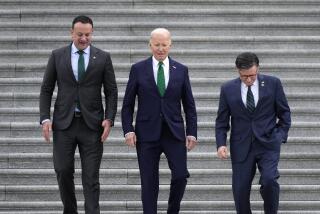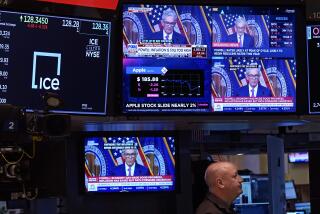Money Supply Expands $1.4 Billion
NEW YORK — The nation’s basic money supply rose again--by $1.4 billion in late August--the Federal Reserve Board said Thursday in a report that pushed interest rates up and bonds prices down.
The latest increase left the measure well above the upper limit of the Fed’s growth target and disappointed traders, who generally had expected it to remain unchanged.
Economists said they did not expect the Fed to take any immediate action to tighten credit in an attempt to rein in the money supply, which would push up interest rates. But they were divided about how long it would be before the Fed stepped in.
The Fed tries to supply enough money to ensure steady economic growth without fueling inflation.
The Fed said M1 rose to a seasonally adjusted $609.8 billion in the week ended Sept. 2 from $608.4 billion in the previous week. M1 includes cash in circulation, deposits in checking accounts and travelers checks.
M1 averaged $606 billion in August, up from $595.8 billion in July.
For the latest 13 weeks, M1 averaged $598.4 billion, a 15.1% seasonally adjusted annual rate of gain from the previous 13 weeks.
The Fed has said it would like to see M1 grow between 3% and 8% from the second quarter of this year through the fourth quarter.
M2, a broader measure, rose $23.3 billion to an average of $2.5133 trillion last month, up from $2.49 trillion in July. M2 is made up of M1 and such accounts as savings deposits and money-market mutual funds.
M3, an even wider measure, rose $22.4 billion to an average of $3.1363 trillion, up from $3.1139 trillion. M3 is the sum of M2 plus less-liquid accounts, such as certificates of deposit in minimum denominations of $100,000.
The Fed issues reports on M1 weekly and M2 and M3 reports monthly.
“The important thing is that the (M1) money number this week exceeded most expectations. The consensus had been no change,” said David Jones, an economist with Aubery G. Lanston & Co., a government securities dealer. “It represents increases for seven consecutive weeks now and leaves M1 $12.9 billion above the upper limit.”
Jones added: “It will have to become an increasing source of alarm of the monetary authorities. So far, the Fed has not responded to this excessive money growth, but that kind of response could be coming within the next few weeks.”
Other indicators released Thursday included:
- The Federal Reserve Bank of New York reported that commercial and industrial loans at major New York City banks rose $985 million in the week ended Sept. 4, compared to a decline of $2 million in the previous week, bringing the total to $60 billion.
- Borrowings from the Fed in the week ended Wednesday averaged $422 million, down from $1.024 billion in the previous week.
More to Read
Inside the business of entertainment
The Wide Shot brings you news, analysis and insights on everything from streaming wars to production — and what it all means for the future.
You may occasionally receive promotional content from the Los Angeles Times.










